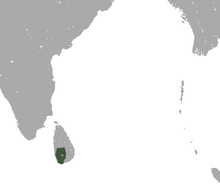Red slender loris
| Red slender loris | |
|---|---|
 |
|
| Scientific classification | |
| Kingdom: | Animalia |
| Phylum: | Chordata |
| Class: | Mammalia |
| Order: | Primates |
| Suborder: | Strepsirrhini |
| Family: | Lorisidae |
| Genus: | Loris |
| Species: | L. tardigradus |
| Binomial name | |
|
Loris tardigradus (Linnaeus, 1758) |
|
| Subspecies | |
 |
|
| Red slender loris range | |
The red slender loris (Loris tardigradus) is a small, nocturnal strepsirrhine primate native to the rainforests of Sri Lanka. This is #6 of the 10 focal species and #22 of the 100 EDGE mammal species worldwide considered the most evolutionarily distinct and globally endangered. Two subspecies have been identified, L. t. tardigradus and L. t. nycticeboides.
The ears are less prominent in L. tardigradus tardigradus compared to Loris lydekkerianus. The ears of L. tardigradus nycticeboides are almost invisible.
This small, slender primate is distinguished by large forward-facing eyes used for precise depth perception, long slender limbs, a well-developed index finger, the absence of tail, and large prominent ears, which are thin, rounded and hairless at the edges. The soft dense fur is reddish-brown color on the back, and the underside is whitish-grey with a sprinkling of silver hair. Its body length on average is 7–10 in (180–250 mm), with an average weight of a mere 3–13 oz (85–369 g). This loris has a four-way grip on each foot. The big toe opposes the other 4 toes for a pincer-like grip on branches and food. It has a dark face mask with central pale stripe, much like the slow lorises.
L. tardigradus tardigradus is reddish brown in the back and creamy yellow below, while L. tardigradus nycticeboides is dark brown dorsally and very light brown in upperparts.
The red slender loris favors lowland rainforests (up to 700 m in altitude), tropical rainforests and inter-monsoon forests of the south western wet-zone of Sri Lanka. Masmullah Proposed Forest Reserve harbors one of few remaining red slender loris populations, and is considered a biodiversity hotspot. The most common plant species eaten was Humboldtia laurifolia, occurring at 676 trees/ha, with overall density at 1077 trees/ha. Humboldtia laurifolia is vulnerable and has a mutualistic relationship with ants, providing abundant food for lorises. Reports from the 1960s suggest that it once also occurred in the coastal zone, however it is now thought to be extinct there.
...
Wikipedia

